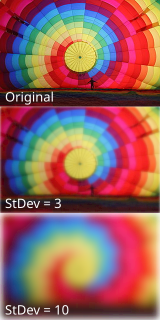
In digital imaging, a pixel, pel, or picture element is a physical point in a raster image, or the smallest addressable element in an all points addressable display device; so it is the smallest controllable element of a picture represented on the screen.
PCX, standing for PiCture eXchange, is an image file format developed by the now-defunct ZSoft Corporation of Marietta, Georgia, United States. It was the native file format for PC Paintbrush and became one of the first widely accepted DOS imaging standards, although it has since been succeeded by more sophisticated image formats, such as BMP, JPEG, and PNG. PCX files commonly stored palette-indexed images ranging from 2 or 4 colors to 16 and 256 colors, although the format has been extended to record true-color (24-bit) images as well.
In computer science, digital image processing is the use of computer algorithms to perform image processing on digital images. As a subcategory or field of digital signal processing, digital image processing has many advantages over analog image processing. It allows a much wider range of algorithms to be applied to the input data and can avoid problems such as the build-up of noise and signal distortion during processing. Since images are defined over two dimensions digital image processing may be modeled in the form of multidimensional systems.
In digital signal processing, spatial anti-aliasing is a technique for minimizing the distortion artifacts known as aliasing when representing a high-resolution image at a lower resolution. Anti-aliasing is used in digital photography, computer graphics, digital audio, and many other applications.

A compression artifact is a noticeable distortion of media caused by the application of lossy compression.

The Canny edge detector is an edge detection operator that uses a multi-stage algorithm to detect a wide range of edges in images. It was developed by John F. Canny in 1986. Canny also produced a computational theory of edge detection explaining why the technique works.

In computer vision, image segmentation is the process of partitioning a digital image into multiple segments. The goal of segmentation is to simplify and/or change the representation of an image into something that is more meaningful and easier to analyze. Image segmentation is typically used to locate objects and boundaries in images. More precisely, image segmentation is the process of assigning a label to every pixel in an image such that pixels with the same label share certain characteristics.

Unsharp masking (USM) is an image sharpening technique, often available in digital image processing software.
Core Image is a pixel-accurate, near-realtime, non-destructive image processing technology in Mac OS X. Implemented as part of the QuartzCore framework of Mac OS X 10.4 and later, Core Image provides a plugin-based architecture for applying filters and effects within the Quartz graphics rendering layer. The framework was later added to iOS in iOS 5.

In computer graphics, a shader is a type of computer program that was originally used for shading but which now performs a variety of specialized functions in various fields of computer graphics special effects or does video post-processing unrelated to shading, or even functions unrelated to graphics at all.

Thresholding is the simplest method of image segmentation. From a grayscale image, thresholding can be used to create binary images.

In image processing, a Gaussian blur is the result of blurring an image by a Gaussian function. It is a widely used effect in graphics software, typically to reduce image noise and reduce detail. The visual effect of this blurring technique is a smooth blur resembling that of viewing the image through a translucent screen, distinctly different from the bokeh effect produced by an out-of-focus lens or the shadow of an object under usual illumination. Gaussian smoothing is also used as a pre-processing stage in computer vision algorithms in order to enhance image structures at different scales—see scale space representation and scale space implementation.

An image gradient is a directional change in the intensity or color in an image. The gradient of the image is one of the fundamental building blocks in image processing. For example, the Canny edge detector uses image gradient for edge detection. In graphics software for digital image editing, the term gradient or color gradient is also used for a gradual blend of color which can be considered as an even gradation from low to high values, as used from white to black in the images to the right. Another name for this is color progression.
A region of interest, are samples within a data set identified for a particular purpose. The concept of a ROI is commonly used in many application areas. For example, in medical imaging, the boundaries of a tumor may be defined on an image or in a volume, for the purpose of measuring its size. The endocardial border may be defined on an image, perhaps during different phases of the cardiac cycle, for example, end-systole and end-diastole, for the purpose of assessing cardiac function. In geographical information systems (GIS), a ROI can be taken literally as a polygonal selection from a 2D map. In computer vision and optical character recognition, the ROI defines the borders of an object under consideration. In many applications, symbolic (textual) labels are added to a ROI, to describe its content in a compact manner. Within a ROI may lie individual points of interest (POIs).

Error diffusion is a type of halftoning in which the quantization residual is distributed to neighboring pixels that have not yet been processed. Its main use is to convert a multi-level image into a binary image, though it has other applications.
Adaptive histogram equalization (AHE) is a computer image processing technique used to improve contrast in images. It differs from ordinary histogram equalization in the respect that the adaptive method computes several histograms, each corresponding to a distinct section of the image, and uses them to redistribute the lightness values of the image. It is therefore suitable for improving the local contrast and enhancing the definitions of edges in each region of an image.
Blend modes in digital image editing and computer graphics are used to determine how two layers are blended into each other. The default blend mode in most applications is simply to hide the lower layer with whatever is present in the top layer. However, as each pixel has a numerical representation, a large number of ways to blend two layers is possible.
The top layer is not necessarily called a "layer" in the application. It may be applied with a painting or editing tool. The top layer can also be referred to as the "blend layer" or "active layer".

Image editing encompasses the processes of altering images, whether they are digital photographs, traditional photo-chemical photographs, or illustrations. Traditional analog image editing is known as photo retouching, using tools such as an airbrush to modify photographs, or editing illustrations with any traditional art medium. Graphic software programs, which can be broadly grouped into vector graphics editors, raster graphics editors, and 3D modelers, are the primary tools with which a user may manipulate, enhance, and transform images. Many image editing programs are also used to render or create computer art from scratch.

In scientific visualization, line integral convolution (LIC) is a technique to visualize a vector field, like a fluid motion, such as the wind movement in a tornado. LIC has been proposed by Brian Cabral and Leith Leedom. Compared to other integration-based techniques that compute field lines of the input vector field, LIC has the advantage that all structural features of the vector field are displayed, without the need to adapt the start and end points of field lines to the specific vector field. LIC is a method from the texture advection family.
In image processing, a kernel, convolution matrix, or mask is a small matrix. It is used for blurring, sharpening, embossing, edge detection, and more. This is accomplished by doing a convolution between a kernel and an image.










